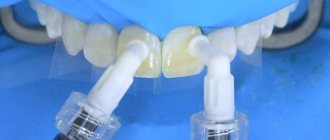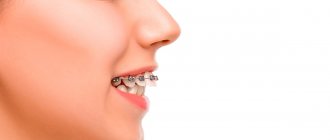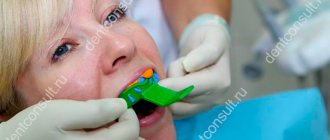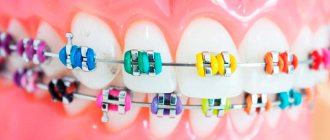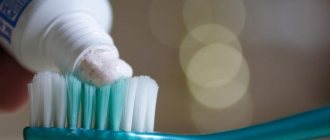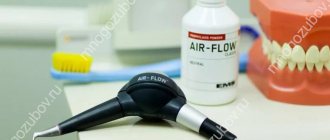To correct an abnormal bite, you can put braces on your teeth. Such orthodontic systems affect bone tissue, muscles and ligaments, and help slowly move teeth into the correct position. Many people are interested in the question: is it possible to put braces on one jaw? You will find the answer in this article.
In this article
- What are braces?
- Are braces placed on one jaw?
- Main indications for partial correction
- Orthodontic correction up to 12 years
- Braces for the lower jaw only for mild crowding
- Treatment for crowded upper anterior incisors
- Closing the gap between the front incisors
- Partial bracket system for preparation for prosthetics
- Absence of chewing teeth on the opposite jaw
- Should I install braces on one jaw or not?
What are braces?
A brace system is an orthodontic device that is installed on the teeth and helps them move in the desired direction. Structurally, this device consists of small plates (directly braces), which are glued to the dental crown at pre-calculated points, and a metal arch. This arc has shape memory and is an active element of the system. Fixed on the plates, it tries to regain its even position and thereby puts pressure on the teeth. As a result, their slow, gradual movement in the bone tissue occurs. Orthodontic treatment not only helps to correct the curvature of individual teeth in a row, it allows you to change the shape and position of the jaw, and restore facial symmetry.
It is preferable to begin orthodontic correction in childhood. But modern medical capabilities make it possible to carry it out even in adulthood and old age.
Most often, an orthodontic device is placed on two jaws at once. The dentist calculates in advance in which direction a particular tooth should move, how much it is necessary to expand the jaw or spread the dentition. Double-jaw treatment is comprehensive and allows you to solve global problems in occlusion correction. It usually takes from several months to several years.
Which is better: regular or lingual braces?
Compared to vestibular (external) braces, lingual braces have both advantages and several disadvantages:
- Aesthetics: even the most attentive interlocutor will not guess that you are undergoing treatment with lingual braces.
- Comfort: internal dental braces do not cause damage to the lips and cheeks, as they do not come into contact with them.
- Predicted result: the lingual brace system is made on the basis of a 3D model, and the patient can see in advance what his smile will look like at the end of treatment.
- Hypoallergenic: systems consist of alloys that do not cause an allergic reaction.
- The ability to correct even the most difficult case of deep bite.
- Cause increased salivation during the adaptation period.
- They may rub the tongue, especially in the first weeks after installation.
- Diction is impaired (the problem is solved within a couple of weeks).
- They have more limitations compared to the vestibular systems.
- Requires more careful adherence to oral hygiene procedures.
- They have a high cost.
Most of the disadvantages of lingual braces are conditional, since the prices of the devices and their level of comfort vary among different models of lingual braces.
Video about lingual braces
Are braces placed on one jaw?
Installing a brace system is one of the most common and effective methods for correcting an abnormal bite, improper closure of the teeth of the upper and lower jaw. Crooked teeth and abnormal jaw position not only spoil a person’s appearance, but also affect his health. Therefore, correcting the bite is important and necessary. But installing braces confuses many people.
Some are concerned about aesthetics, others are concerned about possible inconveniences when wearing the system, others simply want to save on orthodontic correction. And then the patient turns to the doctor with the following question: is it possible to install braces only on the upper jaw or only on the lower jaw.
As a rule, a person knows in advance which teeth he wants to change. And if they are located only on one jaw, then he expects that he will have a partial braces installed, only in the area of the curvature.
The doctor must make such a decision. It may seem to the patient that he has a problem only with the lower jaw, but the dentist sees during the examination that partial correction will not give an effective result. In this case, the orthodontist will insist on a complete correction. If you need a stable result of orthodontic treatment, we recommend listening to the professional opinion of an orthodontist.
Which bracket system is better: self-ligating and ligature designs
Bite correction systems differ in the method of fixing the archwire in the bracket groove. The classic option is ligature constructions. The arch is tightly fixed to each bracket with elastic or metal ligatures. The design is suitable for the treatment of anomalies of varying complexity. It is necessary to visit a doctor once a month to replace the archwires.
Orthos ligature braces
Self-ligating structures do not have elastic and wire elements fixing the arch in the bracket groove. Friction in the system is minimal. Arc sliding occurs under the influence of weak forces. Non-ligation structures do not require monthly visits to the doctor: it is enough to carry out activation once every 2-3 months.
self-ligating Damon Q2
According to the results of research by Khalid S. Hassan from the University of Ed-Dammam, Saudi Arabia, it was revealed that the microbial flora in the oral cavity when using self-ligating systems was lower than when treated with ligature structures. 22 patients participated in the study. In each case, two ligation systems were fixed in the oral cavity: ligature structures were installed on one side, and devices without ligatures were installed on the other. The use of ligature systems caused microbial colonization and increased the activity of the enzyme aspartate aminotransferase. Treatment with self-ligating braces turned out to be a more preferable method of occlusion correction from the point of view of preventing disorders in periodontal tissues.
What are the best braces for a child? Each clinical case requires an individual approach from the orthodontist. Only a doctor, based on the diagnosis and structural features of the young patient’s dental system, offers the most suitable options. As a rule, the issue of aesthetic preferences in children is not as acute as in adults. Teenagers often choose ligature or non-ligature metal systems. A wide variety of elastic ligatures allows you to express the individuality or mood of the child, and the visibility of the design has ceased to be a criterion for choosing a system. Teenagers wear devices with multi-colored elastic elements and do not experience discomfort.
non-ligature Damon 3MX metal
When treating children with braces, it is important for parents to pay attention to teaching the child oral hygiene and motivate them to follow all the orthodontist’s recommendations. Some teenagers, despite the instructions of their parents, pay insufficient attention to hygiene procedures. In this case, installing a non-ligature brace system for a child will be a more preferable option.
Main indications for partial correction
In some cases, it is indeed possible to place braces on one jaw, and this approach will be effective. As a rule, these are situations where the teeth are only crooked at the top or bottom, but the bite is not broken and there is no facial asymmetry. Partial correction may be recommended for the following indications:
- one or two teeth are positioned incorrectly;
- slight crowding of teeth (lack of space - up to 3 mm);
- a gap between the front incisors in the absence of pathological closure of premolars and molars;
- correction of the position of teeth before installing dentures;
- the need to avoid sagging of the upper teeth when their antagonists (opposite units) in the lower jaw are absent.
Diagnostics will show how effective braces will be only on the upper jaw or, conversely, on the lower jaw. It should include a visual examination, x-rays, assessment of the condition of bone tissue and dental roots.
Let's consider cases when it is justified to place braces separately on the upper jaw and separately on the lower jaw.
Smile design development
People with well-aligned teeth and a wide, aesthetic smile have higher self-esteem and are perceived as more attractive and intelligent.12,13 An attractive smile is the sum of many characteristics, including the shape of the lips, the line of the upper lip, the curve of the lower lip, the arch of the smile, the cheek corridor, occlusal plane in the anterior section, as well as dental and gingival components. When determining optimal bracket positioning to improve an individual patient's smile characteristics, we need to consider incisor exposure, smile arc, and anterior torque. Incisor exposure is generally classified as low when there is less than 75% crown exposure of the central incisor, moderate when the patient shows 75-100% of teeth and up to 2 mm of gingiva, and gingival or high when there is more than 2 mm of gingival exposure with a forced smile. 14
The arc of a smile is an imaginary curve formed by the relationship between the incisal and occlusal edges of the upper teeth and the contour of the lower lip. This curve is more pronounced in women and tends to flatten with age.15 The smile arc is considered ideal when there is consistency between the incisal edge of the maxillary incisors and the curve of the lower lip. A discordant or flat smile arc is characterized by a flatter curve of the maxillary incisors compared to the curve of the lower lip when smiling. In some cases, we may even observe an inverted or reversed smile arc.
Hulsey found that one-third of patients receiving orthodontic treatment had flatter smile arches than control patients.16 Ackerman and colleagues noted that the main differences between adolescents who received and did not receive treatment were the width between the canines and the smile arch; 33% of treated patients had a flattened arch compared with only 5% of untreated patients.17
Because the clinical crowns of the upper canines are longer than those of the other anterior teeth, positioning brackets centered on the clinical crowns will cause the canines to appear relatively extruded, disrupting the natural curvature of the anterior teeth. The overall focus on extrusion of the maxillary canines to guide them results in intrusion of the maxillary incisors and thus creates a flatter smile.
Once the patient has a consistent smile arch, brackets must be positioned to maintain the vertical position of the anterior teeth.18 If the smile arch is flat, the upper incisors must be extruded to enhance incisor exposure and maintain appropriate curvature of the upper arch relative to the lower lip.
Smile width is directly related to the facial index (the width of the face relative to its height).19 Thus, our attention to smile arch design should extend from the first premolar to the first premolar, or even to the first molars in some cases. Transversal development is appropriate in patients with a wide smile.
Rice. 1 Changing the height of bracket positioning on the upper incisor causes a change in torque depending on orthodontic mechanics and individual bite pathology. Corrections can be made using archwires or customized braces.
Torque represents another important aspect of the mini aesthetic. Upper incisors in a position of excessive proclination tend to flatten the smile arch.20 The canines must be in a vertical position to smoothly transition from the anterior teeth with positive torque to the posterior teeth with negative torque. This is especially important in patients with wide dental arches.
Some cephalometric angles commonly used to identify maxillary incisor proclination, such as U1-SN or U1-FH, are modified by inclination based on skull structure. This may lead to an incorrect diagnosis of proclination or retroclination when the aesthetically pleasing features are present. The same situation applies when the crowns and roots of the upper incisors have unusual anatomy and their long axes do not coincide.21,22
Correct diagnosis takes into account the position of the lower incisor in terms of stability and functionality. The clinical picture almost always ignores cephalometric data.
Orthodontic correction up to 12 years
Braces are primarily used for children starting in their teens. This is due to the fact that by the age of 11-12 years the formation of the jaws is completed, and the primary bite is replaced by a permanent one. But often, an orthodontist discovers bite problems in a child at an earlier age. Installing partial braces helps solve some of them, as well as prepare teeth for further correction in adolescence.
The doctor can place an orthodontic device on one jaw or individual teeth in order to:
- create space for the eruption of permanent teeth;
- expand one of the jaws;
- close the gap between the front incisors (the so-called diastema);
- correct the incorrect position of one or more teeth that are bothering the child;
- preserve the space left after early removal of baby teeth, which neighboring ones are trying to occupy.
Thus, braces can be placed on one jaw at the age of 9-10 years to solve a specific orthodontic problem. In this case, in adolescence, further, already double-jaw, treatment will be required.
Installation of braces: preparatory stage
Before directly attaching braces to the teeth, the patient will have several meetings with the orthodontist. The preparation algorithm includes:
- A visual assessment of the condition of the oral cavity, during which the doctor examines the proportions of the face, the position of the teeth in the jaw, the structure of soft tissues, bones, and the general condition of the teeth.
- Diagnostic studies. X-rays, OPTG, CT show a complete picture of the oral cavity - the position of the roots, the presence of the rudiments of permanent teeth, if the correction is started before the complete change of bite. The orthodontist also takes several photos of the patient’s face from different angles. This helps the doctor see how much symmetry is broken and take this fact into account when drawing up a treatment plan.
- Surgical stage. It is carried out only when absolutely necessary and comes in two versions. The first is tooth extraction. Dentists strive to preserve every unit of bite, but sometimes this is not possible. Frequent causes of malocclusion are crowded teeth, supernumerary teeth, and in these cases, extraction cannot be avoided. The second reason for surgery is problems with the frenulum. If the frenulum is the culprit of the malocclusion, then plastic surgery is performed.
- Therapeutic stage. Braces are placed only on healthy teeth. This means that tooth decay and other diseases must be cured. Sanitation of the oral cavity is carried out several days before installing braces on the teeth, so that the fillings allow natural shrinkage, the gums and mucous membranes are restored.
- Professional cleaning – removing plaque and tartar. Before installing braces, the enamel of teeth is cleaned for better bonding of surfaces.
- Taking impressions of the jaws. This step is necessary for computer modeling of the correction process and drawing up a treatment plan.
Braces for the lower jaw only for mild crowding
Crowding is the position of teeth when they are too close to each other. As a result, rotation, curvature, and “layering” of each other occur. If slight crowding is observed only on the lower front incisors, while the upper front incisors are positioned evenly and the lateral ones close correctly, in this case, braces are sometimes placed only on the lower jaw. An important condition for this method is that there must be enough space to move horizontally so that the teeth can take the correct position. This treatment method is chosen in cases where the lack of space for alignment is less than 3 mm. With this method, separation of the front incisors is almost always performed - that is, minor grinding of the contact surfaces, which allows you to free 0.25 mm from each surface and in total create those missing 1-3 mm for alignment in the dentition.
Treatment for crowded upper anterior incisors
Braces on the upper jaw only can be placed if crowding is observed on the upper front incisors. The conditions are the same - the space deficit should be no more than 2-3 mm. In addition, treatment should not require expansion of the dentition. In this case, for orthodontic correction it is not necessary to involve the lower dentition.
If you provide space for uneven teeth by expanding the upper row, this will disrupt the closure. As a result, the teeth will “seek contact” with each other, the upper row will become narrow again, and in the long term the goal of orthodontic treatment will not be achieved. Therefore, if it is necessary to expand the upper row of teeth in order to correct crowding, a partial braces system cannot be used; a two-jaw apparatus will have to be installed. Braces can only be placed on the upper jaw if space for teeth is freed up using the separation method (their width is reduced by grinding the contact surfaces).
Is it possible to do without retention and what is it even?
Retention is perhaps one of the most important parts of the entire treatment. Why? Teeth are harmful guys, and they will try to return to their original position, which is comfortable only for them. This is called a relapse. But neither I nor my patient want this. That’s why I really insist on retention, often even suggesting double retention.
What is retention? This is a removable or non-removable device designed to hold the dentition in the desired position. This could be a splint, a retainer (an arch behind the teeth), a night guard, or a plate.
Retainer after braces
Closing the gap between the front incisors
Braces can be placed on the lower jaw if there is a large gap (diastema) between the lower front incisors. In this case, several conditions must be met:
- the lateral teeth close together normally;
- there is an opportunity for a “joint to joint” closure of the front teeth of the upper and lower rows.
If these conditions are not met, it may be necessary to artificially increase the size of those teeth between which there is a gap. This is done using filling material. If the patient is not ready to fill healthy teeth in order to increase their size, then single-jaw treatment of diastema will not suit him, since the doctor will not be able to guarantee the stability of the result.
Will braces ruin my teeth?
Let me say right away that braces do not damage your teeth. But only subject to hygiene rules and doctor’s recommendations. But here it is better to dispel several myths at once:
No. 1 Teeth under braces will definitely deteriorate
Nothing exactly happens under the braces, but the whole problem usually occurs around the braces - if the patient does not brush his teeth after every meal, then caries forms as a result.
Or if the patient has a strong tendency to form plaque (in this case, hygiene should be more careful). But if the patient could not agree on hygiene during treatment, then I usually suggest, and sometimes insist, that the orthodontic treatment be completed.
No. 2: The enamel may come off along with the braces.
When removing the braces, the doctor leaves some of the glue on the tooth, which is then easily removed with a bur, and then the teeth are polished. In this case, the enamel remains intact and unharmed.
#3: Teeth may fall out after braces.
Basically, patients understand that after proper treatment this is in no way possible. Mobility of teeth during treatment with braces - this happens, and this is normal (after all, teeth move, and this is quite logical). Retention, consisting of both removable and non-removable devices (retainers, mouth guards, plates), will help maintain the position of teeth after treatment, which will help keep the teeth in their correct position.
Partial bracket system for preparation for prosthetics
Sometimes braces are placed on only one jaw in preparation for prosthetics or in order to close empty spaces from extracted teeth. In the first case, braces help change the angle of the teeth to make room for an implant or bridge. In the second case, the brace system is used to move the posterior chewing tooth to the place of the previously removed one, thereby closing the empty gap and avoiding prosthetics. It is important to note that such treatment is usually complex and lengthy (tooth movement can take up to four years).
The orthodontist decides how appropriate it is to install a partial brace system for such indications in each specific case.
Types of braces for upper teeth
- Metal is a popular type, reliable and inexpensive.
- Non-ligature ones differ from the others in that they are fixed on a special latch, making them more convenient (in particular, unlike metal ones, you need to visit the doctor less) and more aesthetically pleasing.
- Aesthetic – they differ in the material from which they are made (plastic, ceramic, sapphire), since their goal is to make the fact of wearing braces on the teeth as less noticeable as possible.
- Lingual - similar in purpose to aesthetic ones, but their “invisibility” lies in the fact that they are fixed on the inside of the teeth.
When installing a brace system on the upper jaw, its aesthetic qualities are important. The upper dentition is always noticeable, especially when smiling, so many patients choose either aesthetic or lingual systems. In any case, we at Orto-Artel always discuss this issue with patients when drawing up a treatment plan, comparing the advantages of each type of brace system with individual clinical cases.
Should I install braces on one jaw or not?
If the patient is concerned about the question of whether braces are placed on the lower jaw, then the answer will be positive. An orthodontic device can be installed not only on the lower or upper jaw, but also on individual teeth or areas of the dentition. But the main question is whether such treatment would be advisable. As a rule, installing a brace system on one jaw solves exclusively local dental problems. This process is more difficult to control and provides fewer treatment options. If contraindications are not provided, even a successful result will be short-lived, and the teeth will return to their previous position.
Thus, a dentist planning single-jaw orthodontic treatment must carefully assess the risks, take into account the many factors that will influence tooth movement and predict in advance the effectiveness and stability of the result.
If the doctor sees that solving the problem with a partial braces system will be problematic, he will recommend double-jaw treatment to the patient. Its advantages are that teeth can move in different planes without negative effects such as disruption of contacts between the upper and lower ones. Plus, such treatment is easier to predict and control, and it gives a more sustainable result.
Rules for positioning braces
Due to the convexity of the labial surface of the tooth, the torque generated by the bracket is determined by its height (Figure 1).23 This rule applies to all teeth in the mouth, even with general differences in morphology,24 and especially to displaced teeth.25
After determining the diagnosis and treatment plan for a specific patient, we must follow a standard protocol for positioning brackets. Because direct bonding makes it difficult to position the brackets in their ideal position, indirect bonding may be more desirable from an accuracy standpoint.26 We recommend the following step-by-step procedure.
1. Assess the appearance and shape of each clinical crown.
Before fixing braces, we recommend restoring any worn or chipped incisor edges and adjusting the size of the tooth. This will help establish the correct pink esthetic—ideal gingival contour—after alignment and will ensure restoration of tooth function during occlusion and mandibular movement. Before fixing the brackets, any aesthetic composite material must be added (Fig. 2). On the other hand, when a restoration is likely to increase the normal dimensions, the clinician must decide whether to perform a preliminary restoration or reduce the original dimensions.
2. Assess the original gingival shape and contour.
If a patient has reduced crown height due to changes in passive tooth eruption, gingivoplasty may be advisable to visualize the best positioning of the brackets (Figure 3). If insufficient incisor height is caused by late active eruption, consultation with a periodontist is necessary.
3. Fix the braces first on the dentition of the upper jaw, and then on the dentition of the lower jaw.
TABLE 1. RULES FOR POSITIONING BY HEIGHT.
* Reduced exposure of the upper incisors. **Excessive gum exposure.
The upper dentition, framed by the lips in a natural smile, allows you to visualize the treatment plan from start to finish. Although there are many strategies for positioning braces, we recommend starting with the canine tooth, which controls chewing movements and serves as a transition tooth between the anterior and posterior arches.
4. Adjust the height of your smile.
The height of the canine bracket will depend on the consistency of the patient's original smile and the visibility of the incisors. As tooth exposure increases at rest and with smiling, the degree of gingival positioning of the bracket on the canine must be decreased. As a rule, in a patient with a low smile height (poor visibility of the upper incisors), the bracket on the canine should be placed at a distance of 6 mm from the edge of the incisor, for the lateral incisors the distance is 6.5 mm and for the central incisors - 7 mm (Table 1, Fig. . 4). The height of bracket positioning is determined by the height of the clinical crown in the lateral sections of the jaws, which is greater than in the anterior section of the dentition, where the buccal surfaces are smaller. The size of the crown, and therefore the height of the bracket, is gradually reduced, creating a posterior to anterior discrepancy in the occlusal plane of the maxilla, which will promote exposure of the incisor.
Rice. 2 Composite is added to the mesial surface of the canine and polished with a white bur during the initial appointment to adjust the dimensions of the tooth and restore worn or chipped incisal edges. The prosthetist must complete the restoration at the end of the treatment.
In open bite cases without excessive gingival exposure, we recommend positioning the braces higher on the anterior teeth compared to positioning the braces on the posterior teeth. This will help close the bite by intruding the posterior teeth while extruding the anterior segment.
Rice. 3 Gingivoplasty, used to create the correct contours of the gums before installing braces.
Rice. 4 Recommended anchorage heights on the upper teeth for low smile heights (reduced exposure of the upper incisors).
Rice. 5 Recommended fixation heights on the upper teeth for an average smile height.
Rice. 6 Recommended anchorage heights on the upper teeth for high smile heights (excessive gingival exposure).
For average smile heights, brackets should be placed closer to the center of the clinical crowns, although protection of the smile arch should always be kept in mind. As a rule, braces on the canines should be spaced 5 mm apart, on the central incisors 6 mm apart, and on the lateral incisors in the middle - 5.5 mm (Fig. 5). The height of the back braces also needs to be gradually reduced.
The positioning of braces may mask excessive gingival exposure, depending on the etiology of the gummy smile. Again, the vertical position of the incisal edge is a major factor in avoiding flattening of the consistent smile arch in an attempt to reduce gingival exposure. Our recommended distance for brackets on canines is 4 mm, for central incisors - 5 mm, and for lateral incisors the average distance is 4.5 mm (Fig. 6). The height of the rear braces must also be gradually reduced so that the triangle created by the positioning of the upper braces is less steep (Fig. 7).
Some clinicians may be surprised by the 1.25 mm difference in bracket positioning height between the canine and the first premolar in the case of a low smile. Although it may appear that an irregular pitch would be created between these teeth, the difference in crown size between the canine and premolar allows the point of proximal contact to be more incisal without creating a pitch that would compromise the occlusion (Fig. 8).
Rice. 7A. A 24-year-old male patient presented with an open bite, abnormal incisor exposure, and torque of the maxillary canines before treatment. B. At 30 months, smile esthetics are improved by maintaining a consistent smile arc.
Rice. 8A. Recommended fixation heights for low smile heights. B. Despite the difference in bracket positioning height between the canine and the first premolar, the occlusion was not characterized by the presence of steps.
Rice. 9 Recommended anchorage heights for lower teeth.
Triangle divergence varies among individual patients. Most patients do not need to adjust their braces if they have a low smile height (as shown in Figure 8). It is also important to note that placing brackets too high can promote the development of gingivitis and increase the risk of enamel breakdown during braces removal due to thinner enamel in the cervical area. However, in some cases where the incisor is covered by the upper lip, this approach will be effective.
Another possible issue concerns the idea that canine growth may compromise the protection of the canine during chewing movements. Generally speaking, if the torque is correct in both the upper and lower canines, this protection will not be compromised. If canine protection is not achieved in the third phase of treatment, minor extrusive bends or repositioning of the bracket on the lower canine can help achieve this goal. Posterior group function is also an acceptable result.
5. Perform fixation on the lower jaw dentition.
On the lower dental arch, we recommend fixing braces from the molars to the front teeth. Cone beam computed tomography should be used to assess root parallelism because panoramic radiographs may be unreliable, especially in the canine region.
Rice. 10 Photographs allow you to evaluate the shortcomings and the need to change the position of the bracket. To ensure improved alignment and orientation of the teeth in this case, the brackets on the incisors were rebonded higher (central 1 mm; lateral 0.5 mm) and on the canines more occlusally (right 1 mm; left 0.5 mm). Smile aesthetics improved within four months. Changing the bracket positioning height by as little as 0.25mm on some teeth can significantly improve the smile arch.
The recommended positioning height for brackets and tubes does not change on the lower dental arch (Table 1, Fig. 9). In addition, the morphological characteristics of each individual patient must always be taken into account. Minor changes may be made in the final stages of treatment.
Rice. 11 Star placement* in 25 mm increments for more precise bracket positioning.
Rice. 12A. Asymmetry of gingival height visible on the final occlusal anterior photograph. B. Asymmetry corrected by electrosurgical gingivoplasty.
Frequent and consistent photographs—not only in occlusion, but also in the frontal occlusal plane—will help assess the curvature of the smile and the dental and gingival components (Fig. 10). This photographic evaluation is usually recommended after the alignment phase, when the brackets must be repositioned to adjust the smile arc as needed.
In some cases, a 5mm difference between two teeth will be too large. Our solution was to manufacture the positioning star* in 0.25 mm increments to ensure more accurate positioning, especially during the repositioning phase (Fig. 11).
In some cases, additional procedures will be required to achieve the ideal balance between the dental and gingival components of the smile. For example, if gingival tissue disharmony is detected on the occlusal frontal image, a periodontist should be consulted about the possibility of gingivoplasty (Figure 12). Small details like these can improve treatment outcomes by adding symmetry and balance to the patient's final smile.
*TD Orthodontics, Monterrey, Mexico; www.tdorthodontics.com.
